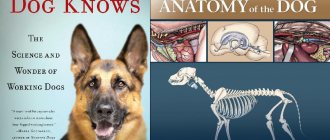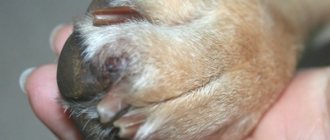Various traumatic injuries to the animal’s body are a common occurrence in the practice of dog breeders. The tail in dogs is most often susceptible to various pathological processes. Clinical signs depend on the nature of the traumatic process.
If you notice possible damage to your pet's tail, you need to take the animal to a veterinary clinic as soon as possible. At first glance, minor injuries can turn out to be serious pathologies - displacement of the vertebrae, fractures, gangrene, which are extremely difficult to treat.
Major diseases and damage to the tail in dogs
In the clinical practice of veterinarians, there is a clear distribution of pathological changes in the tail of a dog. There are mechanical damage and processes that arise as a result of complications. Mechanical damage to the tail occurs due to trauma. Various wounds, bruises, and vertebral fractures occur as a result of bites, sudden lifting of the tail, and pinching.
Tail curvatures of a congenital or acquired nature are often diagnosed. In the case of congenital deformities, the cause is anomalies of a genetic nature. Acquired ones arise due to dislocations, fractures and improperly fused tissues.
Main dog tail injuries and pathologies:
- ulcers;
- fractures;
- eczema;
- intervertebral hernia;
- gangrene.
The clinical picture in most cases is clearly expressed. So, as a result of a tail injury, with damage to the tail artery, severe hemorrhage occurs. Damage located near the base of the tail causes phlegmon, spreading to nearby tissues, rectal tissue. As a result, pararectal phlegmon, fistula or paraplegia may develop.
When the tail vertebrae are fractured, the animal practically does not move the appendage, and when palpating the site of the lesion, the animal experiences pain. The skin at the fracture site has a higher temperature than the rest of the stationary part, which remains cold due to poor circulation.
Note! If there is any abnormality in the dog’s tail, you must contact a qualified specialist. This will allow you to quickly identify the pathology and prescribe adequate treatment.
Causes of crease
Some breeds may have a tail that does not meet the standard. There is also such a deviation as a crease in the tail. Most often this is a congenital defect. Some dog owners believe that this is the result of injury, but in fact this appearance is given to the tail by a modified wedge-shaped vertebra or two vertebrae fused at an angle.
This is not an injury - it is a consequence of a mutation and can be inherited. This irregular shape of the vertebrae develops during the embryonic stage.
IMPORTANT! Animals with hereditary mutations are excluded from breeding and are not allowed to participate in exhibitions. They are also spayed or neutered as early as possible to eliminate the possibility of accidental mating.
Ulcer
A dog's tail is as vulnerable as other organs of a four-legged friend. One of the most common problems that occurs in dogs is ulcers. Depending on the stage of development of the pathology, there are several forms of tail ulcers:
- initial;
- developing;
- advanced ulcer.
Each form is characterized by certain symptoms and manifestations. So at the initial stage, the owner may notice hair loss and the appearance of a focus of inflammation. The developing form of the ulcer is characterized by expansion of the wound, covering new areas of the skin. In advanced stages, the ulcer affects the root part of the tail, causing necrosis and death of the tail vertebrae.
Causes
There is no single cause of tail ulcers in dogs. Doctors suggest that the main causes of this pathology are:
- mechanical damage to tissue structures;
- internal diseases of organs;
- allergic reactions in an advanced stage;
- violation of the diet.
Symptoms and diagnosis of pathology
The basic sign of an incipient tail ulcer is hair loss in the tail . With further development of the pathology, other characteristic signs appear:
- the appearance of a wound surface;
- rapid spread of focal inflammation;
- the appearance of bleeding from the wound;
- pain in the animal.
To make a correct diagnosis and further prescribe adequate treatment, a consultation with a veterinarian specializing in dermatology is necessary. An accurate diagnosis is made only after passing all the necessary tests and examination by a veterinarian.
Diagnostics
It is not easy to check what caused the defect in your pet. The most informative diagnostic method is an x-ray, which shows the true cause of the fracture. But even this cannot guarantee the accuracy of the diagnosis 100%. The fact is that a tail fracture often manifests itself as a slight thickening, the etiology of which is unclear. Experienced veterinarians believe that when there is a mechanical violation of the integrity of the tissue (fracture, bone puncture, etc.), a so-called bone callus forms at the site of injury. However, if bone destruction occurred long ago, the appearance of the damaged area may be no different from genetic pathology.
Tail fractures
The owner of a four-legged friend may notice strange behavior of the pet and abnormal condition of the tail. The animal becomes nervous and quite aggressive. The dog's tail looks unnatural; one part protrudes slightly. In most cases, the injured part heals on its own. But not in all cases, healing occurs successfully; in addition, the development of consequences that affect the general well-being of the pet, namely physiological processes, cannot be ruled out. This is due to the fact that the vertebrae and bones that make up the tail are unusually rich in blood vessels and nerve fibers.
Causes
The vast majority of causes of tail fractures are due to external factors.
The main reasons are:
- pinching the tail in a door or window;
- fracture of a tail fragment due to a collision;
- fight with other dogs;
- disturbances in the functioning of body systems.
Owners of decorative breeds of dogs become frequent visitors to veterinary clinics. The animals obtained as a result of selective work have an attractive exterior, but health, namely the strength of the bone skeleton, is sacrificed for beauty. Pathological fragility of bone structures causes fractures with minor injuries. In the practice of breeders of decorative breeds, congenital fractures occur that animals receive while still in the womb.
Types of fractures and symptoms
Tail injuries are visible to the naked eye. Often, the owner of the animal himself can observe the process of damage or be the culprit of the injury. The tail area protrudes greatly, the animal experiences severe pain, and the tail does not move at all. There is a specific classification of fractures according to their origin, location, nature of damage and direction according to the axis.
According to the nature of the damage:
- Open - damage affects not only bone structures, but also tissues located nearby. Open fractures are complicated by hemorrhages and infectious lesions.
- Closed - have no external damage. This allows you to maintain sterility, avoid infection of the tail and facilitate the healing process.
In addition, fractures are distributed according to the degree of damage to bone structures, the number and nature of the displacement of fragments, according to their anatomical nature.
The main symptoms of a fracture in a dog are:
- visible curvature of the tail;
- severe pain when trying to palpate;
- aggression when palpating the affected area;
- complete loss of motor activity.
Treatment of pathology
After diagnostic measures, including x-ray examination, computed resonance tomography and a full examination of the animal by a veterinarian, the correct treatment is prescribed, including conservative and surgical techniques.
The conservative technique includes the use of painkillers and the procedure for compiling fragments (if there is such a need) and the application of a special splint and plaster. To prevent the dog from touching its tail, a collar is placed on its neck. It is important to ensure that the bandage secures the adjacent joints and that the splint does not compress the blood vessels in the tail. The splint is applied for 2-3 weeks. Complete fractures require the application of a splint and polymer plates for up to 1.5 months.
Conclusion
The Pomeranian Spitz needs constant care and attention. This is the only way to notice a problem with the tail in time and be able to correct it.
If the reason for a pet’s tail drooping is a genetic predisposition, then in no case should you deprive him of his owner’s love, because he is not to blame for this situation.
Have you read anything important or useful for yourself? Then be sure to share our article with your friends.
Tail eczema
A skin disease often reported in pets is eczema. This is a dermatitis that can affect the deep layers of the skin. In most cases, this type of pathology is observed in older dogs and those with thick undercoat.
Reasons for appearance
The main causes of eczema in dogs are skin parasites, dust and aggressive substances. Factors that may predispose to the development of eczema are:
- Improper care of your pet - insufficient care or excessive washing with shampoos and conditioners.
- Malnutrition – an unbalanced diet can cause allergic reactions, including eczema.
- Hormonal imbalances and stress factors lead to stress on the nervous system, causing health problems.
- Diseases of the internal systems of the body, acute and chronic.
- Increased dryness, causing the development of dermatitis.
Symptoms of the disease
The presence of the first stages of eczema is quite difficult to detect. It is especially difficult to see the development of pathology in dogs with thick coats. In the first stages of eczema development, small red spots appear on the root of the tail. Over time, they begin to merge into one large spot. In the center of such a spot, an abscess forms, bursting and affecting all the large adjacent skin.
In addition, a characteristic symptom of tail eczema is a change in coat . In affected areas, the hair becomes stiffer and more ruffled, and then begins to fall out. The dog feels significant discomfort, as the resulting pustules on the skin burst, damaging new areas, causing pain.
Treatment of the disease
The basis of treatment is to search for the cause that has become fundamental to the development of eczema. It is important to contact a veterinarian in a timely manner without delaying treatment. An additional examination may be prescribed, including an ultrasound examination, a general blood test and urine test. Treatment of the disease involves the following points:
- carrying out antiparasitic treatment against fleas and ticks;
- eliminating exposure to sunlight and excessive heat;
- isolation of the animal from contact with chemicals.
Treatment involves taking antihistamine-type medications and sedatives. During therapy, it is recommended to isolate the animal from the tail area by wearing a special collar. This is necessary to prevent inflammatory processes and the introduction of pathogenic bacterial microflora.
Prerequisites
Doctors consider the main cause of the pathology to be a gene mutation that leads to a disruption of the protein-molecular balance in the embryo, and, as a consequence, a change in the structure of the cartilaginous and bone formations of the spinal column. The tail, as an extension of the spine, most often suffers from such mutations.
The possibility of such disorders was first discussed in the early 30s of the 20th century, when genetics, as a science, made a serious breakthrough in creating chains of inheritance of diseases. According to researchers, a dominant triple gene mutation that appears simultaneously leads to pathology.
If only two incorrect genes are present, puppies may suffer from incomplete teeth and various pathologies of the musculoskeletal system (muscle atrophy, underdevelopment of bone tissue).
A single dominant mutation is generally lethal, that is, it leads to the death of embryos or newborn puppies.
The insidious thing about a kinked tail is that it is very difficult to notice right away, whereas most congenital pathologies (such as cleft palate) are visible at birth. However, even careful palpation of the tail at this age does not guarantee detection of the problem. The baby's soft elastic cartilage, already affected by the disease, easily straightens under a person's hands. Only a doctor or breeder with extensive experience and sensitive fingers can find a small thickening on the tail, which can later turn into a kink. When purchasing a puppy at the age of 60-75 days, most owners are not even aware of the possible trouble. And only after a few months (and sometimes even years), during the process of ossification of the cartilaginous tissue, the fracture becomes noticeable. Most often, inexperienced owners believe that through negligence they themselves injured the baby’s tail, especially since curious puppies, poking their noses everywhere, often end up under the doors or feet of household members.
Intervertebral hernia
Discopathy or intervertebral hernia is a fairly common phenomenon that occurs in all types of large breeds of dogs. Four-legged friends obtained as a result of many years of selection - Pekingese, Japanese Chins and Dachshunds - are also susceptible to the development of pathology.
Muzzle
Photo: Chihuahua face according to the standard
According to the standard, the face of a Chihuahua should look like this:
- The Chihuahua's skull is small, wide at the base and tapering towards the nose.
- The nose is neat and short, looking up.
- Lips and cheeks are dry, poorly expressed.
- The standard bite is straight or scissor.
- The eyes are large and beautiful, preferably non-protruding and dark in color.
- The ears are large and erect, rounded upward, and in a calm state may be slightly drooping.











